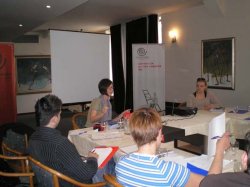
Institutional communication is in the function of increasing the transparency and accountability of the government authorities towards citizens, which implies a two-way dialog as well, or the openness of government towards the impact and contribution of public on government policies.
“Improvement of the administration image will surely depend on its openness. Without successful internal and external communication there is no successful public administration”, has been said, besides others, by the Senior Adviser in the Public administration reform coordinator’s office, Marina Kavaz – Siručić, while talking about “Institutional communication” at the session of the Academy for political leaders in BiH, which has been held on Saturday (June 6, 2009) in Sarajevo.
Kavaz – Siručić has talked to the young political leaders on types of communications in administration, as well as on the weaknesses of institutional communication. She has warned that the administration today does not measure the results of its communications, does not implement the research of public opinion, and by not doing it, it does not have a feedback if its communication is (non) successful.
“Weakness of the institutional communication is also in non-existing of the information transfer system, and, besides others, monopoly of information”, has been said by Kavaz-Siručić, and added that there is a room to improve it all, through understanding the information as a resource.
Political leaders have criticized administration for being slow, huge and bureaucratic, but they have also concluded that there are some visible improvements, and as a good example they have stated the computerization of some BiH municipalities.
“Institutional communication” was only one from the list of themes which the future politicians, who are participating in the one-year program of the Academy for young political leaders in BiH, have been dealing with. In the previous two generations, 51 representatives of political parties from 13 BiH cities have participated in this program.
